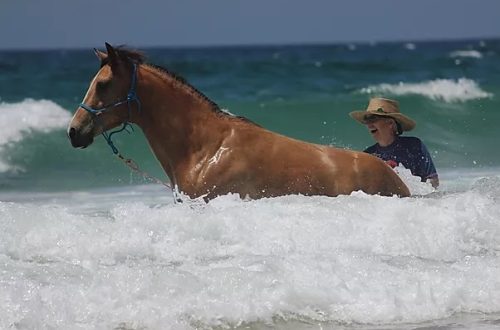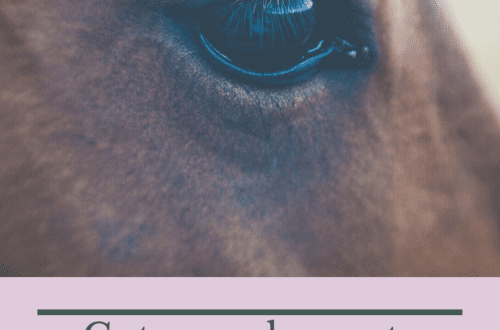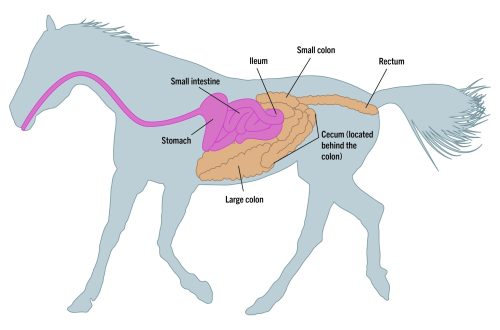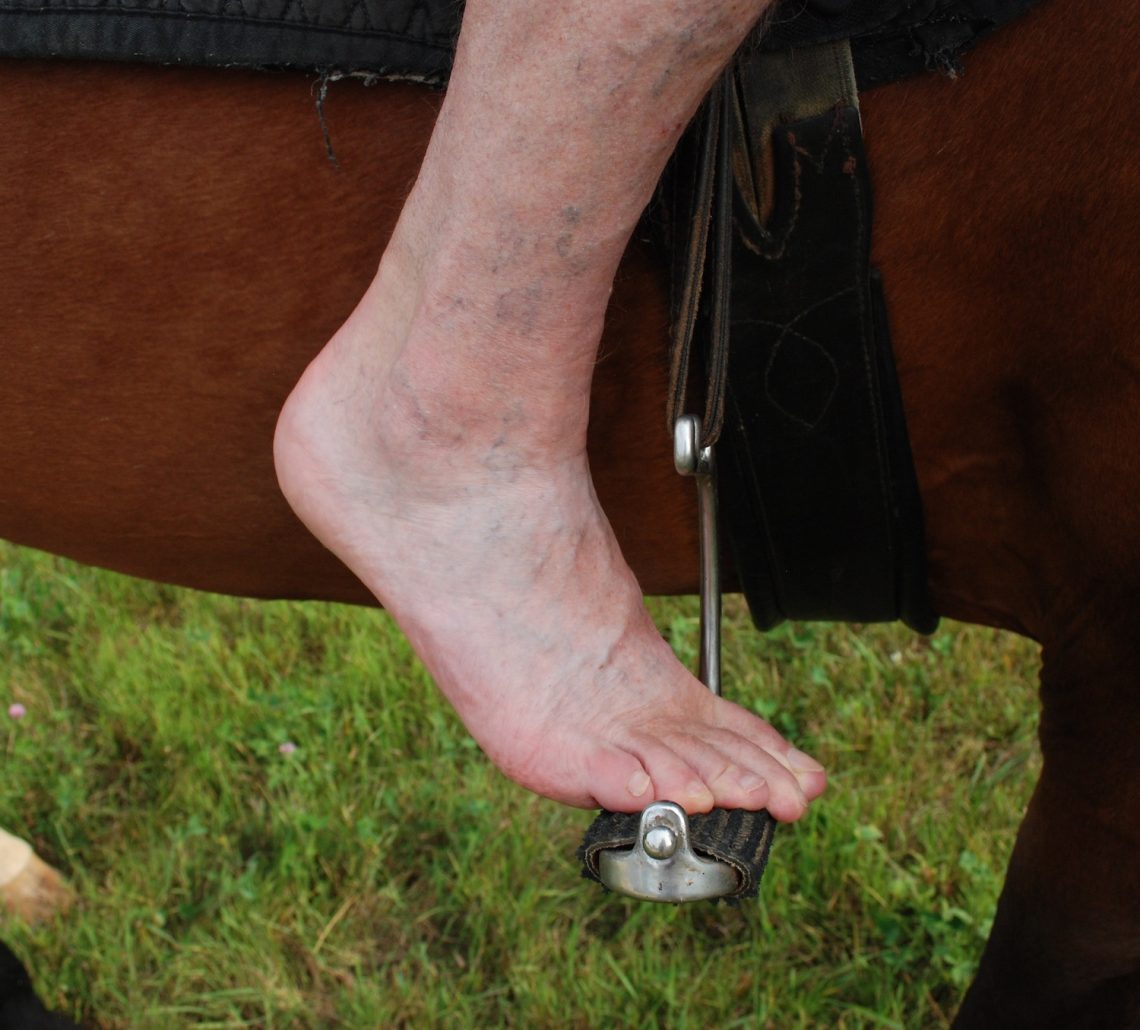
Analyzing the position of the foot in the stirrup
Analyzing the position of the foot in the stirrup
1. Feet become especially important parts of your body when it comes to riding, because the correct seat in the saddle is based on the correct distribution of the weight of the rider between the seat and feet. This does not mean that you should press down with your buttocks and feet. You simply allow your weight to be evenly distributed due to the force of gravity acting on your body.
1.1. Your feet should:
- Lie in the stirrups without pressing them. Distribute the weight evenly across your legs to ensure this.
- Apply some pressure to keep the stirrup directly under the balls of the big toes on the widest part of the foot.
- The pressure on the left and right stirrup should be the same, uniform.
- The heels are slightly lower than the toes (fig. a), but they should not be forced down.
- When viewed from the front, the feet should be parallel to the ground (Fig. b, above). The base of the stirrups and the widest part of the feet should be parallel to the ground.
- Fingers look forward or almost forward. Their position should not be forced!
- You should feel a sense of security and stability.
As you can see in the figure below, our feet have a rather complex structure, including many elements – bones, soft tissues, ligaments and tendons.
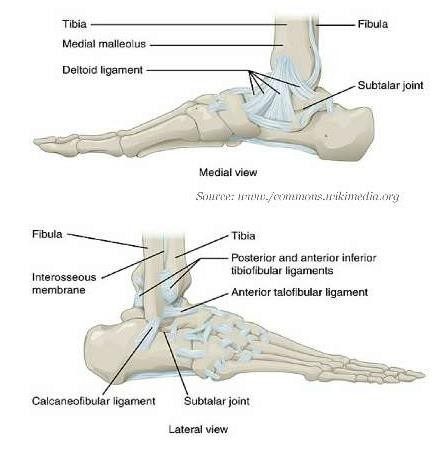
While we all know how the feet should ideally be positioned in the stirrup, practice shows that riders often run into some problems.
1.2. Your feet may take on incorrect positions and experience discomfort.
- Too sagging heel, which does not allow the rider to absorb the movements of the horse.
- The widest part of the foot and the stirrup are not parallel to the ground (at an angle).
- The toes become numb (especially the outer ones).
- The foot is turned too far inward.
- Pain (usually in the instep of the foot).
- Uneven distribution of weight on one foot.
- Periodic total or partial loss of one or both stirrups.
If you force your heels down, you lose the shock-absorbing ability of your lower leg (it is already in a state of tension). When riding, your foot will go far forward (picture on the left).
Your stirrups should stay in the correct position automatically – you don’t have to think about the position of your feet all the time. The stirrup must not move along the foot or come off it while riding.
1.3. What to do, if …
1.3.1. … the foot is not parallel to the ground?
If the foot is not parallel to the ground, then this means that you are twisting the leg at the ankle. If you have an assistant, then he will be able to see this and tell you. Ask him to stand in front of the horse and take a picture of your feet so you can see the problem. If you are working in an arena with mirrors, then stop in front of one of them and check the position of the feet.
If your horse has a very rounded body and short legs (usually found in children), you will most likely need slanting inserts in the stirrups, as straight lines can be difficult for you to work with. You need to relax your ankle and foot and not twist them in any direction.
The rider twists the foot, and a gap appears between it and the base of the stirrup (figure on the left). The entire wide part of the foot should be evenly spaced on the tread. Using oblique inserts can help, but some riders complain of pain when using them (photo on the right).
Experiment with protectors. Make sure that your foot position is not the result of foot structure or injury.
In the picture below, we see how the slanting inserts align the base of the stirrup and make it parallel to the ground. Adjust the inserts until your foot is properly in the stirrup.
Solutions
- Once you’ve got the stirrup treads parallel to the ground, consider how you feel at the widest part of each foot.
- If you feel that your foot touches the stirrup unevenly, try to equalize the pressure on the stirrup. Distribute it evenly across the widest part of the foot.
- If you have been riding with a twisted foot for some time, you will be unaccustomed to new sensations. You may still have to press on the inner edge of the stirrup yourself at first (figure below).
- Once you’ve corrected your stop positions, temporarily work on something else, get distracted, and then recheck where they are.
- Work until your foot is evenly and parallel to the ground in the stirrup without your continuous control.
Remember: when you change the position of some part of your body, at first you will experience strange sensations. This is because your brain is trying to return everything as it was, because it considers the “old” version to be correct. After some time, the brain will consider the new option “correct”, and you will no longer have problems. You will not need to constantly monitor and check the new position – it will be maintained automatically.
1.3.2. … feet are numb?
The twisting of the leg described above causes numbness of the feet, especially on their outer side. The twist can be the result of the rider trying to wrap around the horse’s flanks. Most often, this is because he was taught that way (Figure A).
This can also happen if the rider has been taught to turn the feet inward. This provokes the occurrence of unnatural fractures of the joints (Figure B).
In fact, it is physically impossible to clasp a horse with your legs. But in an attempt to do so, riders end up turning their legs outward. This problem is further exacerbated if the rider has unstable lower legs.
Some riders maintain the same amount of pressure on both stirrups, but push too hard on them. It is impossible to maintain the correct position of the stirrups if you are pushing down. The rider’s feet rest on the stirrups and create a certain amount of pressure to keep the stirrups in place. If you press too hard on the stirrups, you will lock up your joints and your leg won’t be able to cushion, and you will push yourself up, moving your center of gravity away from the saddle.
Most often, this problem occurs in riders with non-elastic shins.
The rider (photo on the left) presses hard on the stirrup and lowers the heel down. The knee also looks tight. Legs go far forward and swell. Less pressure and a relaxed foot allow the rider to position the leg correctly with the shin under the thigh (picture on the right).
Solutions
- Think about the pressure of the feet on the stirrup, even if the feet do not become numb.
- Stop the horse, lift your feet slightly up, tear them off the stirrups.
- Lower them gently down, allowing them to relax, thanks to gravity, into a normal position. Notice the new sensation – not like the one you get when you push down.
- If you have a helper, relax your leg and ask him to lift your foot up. If your leg is really relaxed, then it will do its job relatively easily.
- Have your assistant raise and lower each of your legs and then tell you which one was easier/harder to “handle”.
- Focus on the new light feeling in your feet and remember it.
- If necessary, work on it a little more.
- Do other work and focus on your feet again. Do you still feel light or are you pushing down again?
- Then do a little circle work and let your legs relax as much as possible and go down from the hips.
- Ask an assistant to take a photo of you. You will surely see the difference: your knees and hips will lie much more relaxed than when you pressed on the stirrups.
- Keep practicing this lesson until the feeling of lightness in the foot is permanent.
1.3.3. … the feet are at the wrong angle?
You should not make an effort to keep your feet facing forward. There is a fairly common the delusion that your feet should be pointing straight ahead (or worse, inward!). If you try to do this, your joints will turn out at unnatural angles (up to the joints of the hips) (see the next photo and photo B in paragraph 1.3.2) .
Forcing your heels down (they should drop by relaxing) can also cause your feet to turn away from the horse’s side.
In fact, if the foot is slightly turned outward from the side of the horse, then this is quite normal. Perhaps this situation may be associated with a trauma once received, which you might have forgotten about.
Some riders try to forcefully turn their feet to the side of the horse or keep them parallel to it. If this position is not natural for you, you will get a lot of pain and will not be able to effectively use the controls.
1.3.4. … pain in the feet?
Painful sensations appear due to the fact that riders tense up, get nervous and pinch their feet, twist their toes. Note that the tension in the foot affects the tension in the entire body of the rider!
Solutions
- First of all, if you think that your problem is due to insecurity, you need to seek the help of a trainer and work on the fit.
- Concentrate on your feet and specifically strain them as much as possible.
- Then relax them as much as possible – let them “spread” inside your shoes.
- Make sure your shoes allow you to do this. If the shoes are uncomfortable (too small, too hard, crushing), change them.
- Remember the feeling that arose in the feet when you changed tension to relaxation.
- Work on something else, and then return to the feet again.
- Practice until the new feeling becomes “normal” for you.
Some riders feel pain while riding because they wear shoes with orthopedic insoles all the time in everyday life, and riding shoes do not give them the same support.
Solution
- Order orthopedic inserts for your riding shoes.
Another reason why feet can hurt is injuries suffered in the past.
Solutions
- Experiment with different shoes and stirrups. Try different protectors and stirrup inserts. You can even try bandaging your feet – it can help.
- Try experimenting with stirrups with a wide base. They distribute weight across most of the foot.
1.3.5. … uneven distribution of weight on the feet?
A very common cause of this may be a previous injury to one leg. An indicator that the weight is unevenly distributed is the fact that you are more comfortable riding in one direction and feel less balanced when changing direction. You may also tend to lose the stirrup on only one side.
Solutions
- Remember if you had leg injuries in the past (joints, tendons, ligaments, muscles). This will tell you the reason for the uneven distribution of weight on the feet.
- This problem was also mentioned in section 1.3.4.
The rider (picture below) has an old calf injury. The weight on the feet is unevenly distributed – one heel is lower than the other.
1.3.6. … loss of stirrups?
The loss of stirrups is often associated with the rider squeezing the knees or even the legs too tightly along the entire length, believing that this will help him stay in the saddle.
This problem is widespread. The corresponding habit is very difficult to eradicate. Pinching your horse with your legs may be because your joints are tight, or you have been taught to ride in a similar way. Perhaps you yourself feel insecure, nervous and trying to stay on the horse in this way.
Pinching the horse with the knees causes the legs to lock up and the feet to be insecure. stirrups (picture on the left). The problem may arise from stiffness in various parts of the body or be the result of fear or distrust of the horse.
Notice how the relaxed knee allows the lower leg to better contact the horse’s side and the foot to lie better in the stirrup (right picture).
When a person clamps down and assumes the “fetal position”, this indicates that his brain is signaling danger. This results in the rider pulling their knees up and pulling their arms in towards the body. Many riders do this when they feel insecure, without even realizing that they are in this posture. And the pose itself, in turn, makes a sensitive horse is more restless and tense as he feels more pressure on his flanks. Keeping up the pressure is the last thing you need to do to stay on the horse.
To stay in the saddle, you need to do the exact opposite of what your brain tells you to do.
Inexperienced riders get pinched and “twisted” as soon as some kind of emergency occurs. Experienced riders, on the other hand, try to relax and distribute weight properly, which helps them to control the situation without fear of falling.
Developing you as a rider involves going against the grain of your brain by requiring you to tighten up (fig. A) when you need to distribute the weight properly (fig. B).
Experienced riders know to get into the “fetal position” if a fall is already in progress. The falling rider should curl up and attempt to roll on the ground as they fall. This fall style can help you avoid injury.
Solutions
- If you tend to pinch your legs and lose your stirrups for this reason, try to relax and control the tightness in your leg.
- If this is due to uncertainty, contact the coach and work on this problem.
- In any case, you need to work on the landing under the guidance of a coach or instructor.
1.3.7. … the foot is not deep in the stirrup?
In this case, the stirrup will eventually lie diagonally across the foot (Fig. A). This may be the result of incorrect initial training.
Sometimes riders place the foot in the stirrup on the toes rather than on the widest part of the foot and the ball of the big toe (Figure B). The foot in this case does not receive sufficient support.
Solutions
- Place the foot in the stirrup correctly (you may have to pay attention to the problems described in paragraph 1.3.1). Work and control the position of the foot until it becomes “the only right one” for your brain.
- In the end, with proper work over time, you will not need to think that your stirrup moves along the foot and goes under the fingers.
- This problem can occur if the weight is not evenly distributed on the left and right foot.
By analyzing your problems with the position of the foot in detail, you can determine their source, and therefore eliminate them. We hope you find this article helpful!
Jane Myers (source); translation by Valeria Smirnova.



